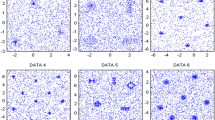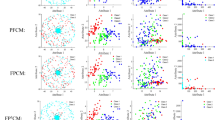Abstract
In this paper, we proposed a new clustering algorithm named KGPFCM algorithm, based on the Generalized Possibilistic Fuzzy C-Means (GPFCM) algorithm and the Kernel method. The presented algorithm projects features in a nonlinear high dimensional input space into a high-dimensional linear output space, which preserves the locality of structural properties, thus improving the ability of the GPFCM algorithm to handle high-dimensional data. However. In addition, KGPFCM algorithm uses in addition to the Euclidean distance, further powerful norms more adapted to various complex problems. Moreover, compared to PFCM, GPFCM and two other recent algorithms like RSFCM and LPFCM methods, KGPFCM algorithm corrects many shortcomings, and the use of Kernel method provides a solution to the high dimensional space and the problem of nonlinear separable input space, hence, KGPFCM is regarded as a unified model that combines two important approaches in clustering technique. Therefore, we applied the KGPFCM algorithm as a new image clustering method based on the kernel technique and we utilized Jacobi orthogonal moments to extract the feature vectors from the images. Experimental results on some benchmark data sets show the effectiveness of KGPFCM algorithm in comparison with GPFCM and some state-of-the-art methods to detect cluster centers accurately and to give satisfactory results in image clustering field.











Similar content being viewed by others
Data availability
This manuscript has associated real data in data UCI Machine Learning Repository, https://archive.ics.uci.edu/ml/index.php.
The data used to support the findings of this study are available in: Coil-20: https://www.cs.columbia.edu/CAVE/software/softlib/coil-20.php.
MPEG-7-CE: https://dabi.temple.edu/external/shape/MPEG7/dataset.html.
References
Chester U, Ratsaby J (2013) “Machine Learning for Image Classification and Clustering Using a Universal Distance Measure”, International Conference on Similarity Search and Applications, SISAP 2013: Similarity Search and Applications pp 59–72, Part of the Lecture Notes in Computer Science book series, (LNCS, volume 8199)
Stetco A, Zeng X-J, Keane J (2015). Fuzzy C-means++: Fuzzy C-means with effective seeding initialization. Expert Syst Appl 42(21):7541–7548
Cebeci Z, Yildiz F (2015) Comparison of k-means and fuzzy c-means algorithms on different cluster structures. J Agric Inf 6:13–23
Ruspini EH, Bezdek JC, Keller JM (2019) Fuzzy clustering: a historical perspective. IEEE Comput Intell Mag 14(1):45–55
Naderipoura M, Hossein M, Zarandia F, Bastanib S (2022) A fuzzy cluster-validity index based on the topology structure and node attribute in complex networks. Expert Syst Appl 187(115913):115913
Rubio E, Castillo O, Valdez F, Melin P, Gonzalez CI, Martinez G (2017) An Extension of the Fuzzy Possibilistic Clustering Algorithm Using Type-2 Fuzzy Logic Techniques. Adv Fuzzy Syst 7094046:1–7094046:23
Bora DJ, Gupta AK (2014) A comparative study between fuzzy clustering algorithm and hard clustering algorithm. Int J Computer Trends Technol 10:108–113
Zadeh LA (1965) Fuzzy sets. Inf Control 8(3):338–353
Hartigan J (1975) Clustering algorithms. Wiley, New York
Darken C, Moody J (1990) Fast adaptive k-means clustering: Some empirical results. Proc of Int Joint Conf Neural Netw 2:238–242
Bezdek J (1980) A convergence theorem for the fuzzy isodata clustering algorithms. IEEE Trans Pattern Anal Mach Intell PAMI 2(1):1–8
Bezdek J (1981) Pattern recognition with fuzzy objective function algorithms. Plenum, New York
Cebeci Z, Kavlak AT, Yıldız F (2017) Validation of fuzzy and possibilistic clustering results. International Artificial Intelligence and Data Processing Symposium, IEEE, Turkey
Dave RN, Sen S (2002) Robust fuzzy clustering of relational data. IEEE Trans Fuzzy Syst 10:713–727
Park DC (2010) Intuitive fuzzy C-means algorithm for MRI segmentation. IEEE, International Conference on Information Science and Applications(ICISA), Seoul, Korea (South), pp 1–7
Huang HC, Chuang YY, Chen CS (2012) Multiple Kernel Fuzzy Clustering. IEEE Trans Fuzzy Syst 20:120–134
Şanlı K, Apaydın A (2006) Robust kümeleme yöntemleri. Anadolu Üniversitesi Bilim ve Teknoloji Dergisi 7:33–39
Ozdemir O, Kaya A (2018) K-medoids and fuzzy c-means algorithms for clustering CO2 emissions of Turkey and other OECD countries. Appl Ecol Environ Res 16:2513–2526
Krishnapuram R, Keller JM (1993) A possibilistic approach to clustering. IEEE Trans Fuzzy Syst 1(2):98–110
Almeida RJ, Sousa JMC (2006) Comparison of fuzzy clustering algorithms for clustering. IEEE International Symposium on Evolving Fuzzy Systems, UK, pp 112–117
Barni M, Cappellini V, Mecocci A (1996) Comments on a Possibilistic approach to clustering. IEEE Trans Fuzzy Systems 4(3):393–396
Timm H, Borgelt C, Doring C, Kruse R (2001) Fuzzy cluster analysis with cluster repulsion. Presented at the Euro. Symp. Intelligent Technologies (EUNITE), Tenerife, Spain
Timm H, Kruse R (2002) A modification to improve possibilistic fuzzy cluster analysis. In: 2002 IEEE World Congress on Computational Intelligence. 2002 IEEE International Conference on Fuzzy Systems. FUZZ-IEEE’02. Proceedings (Cat. No.02CH37291), Honolulu, vol 2, pp 1460–1465
Timm H, Borgelt C, Doring C, Kruse R (2004) An extension to possibilistic fuzzy cluster analysis. Fuzzy Sets Syst 147(1):3–16
Gustafson D, Kessel W (1978) Fuzzy clustering with a fuzzy covariance matrix. In: Proc. IEEE Conf. Decision and Control, San Diego, vol 2, pp 761–766
Pal NR, Pal K, Bezdek JC (2004) A new hybrid c-means clustering model. Proceedings of the IEEE International Conference On Fuzzy Systems 1:179–184
Pal NR, Pal K, Bezdek JC (1997) A mixed c-means clustering model. IEEE Int. Conf. Fuzzy Systems, Spain, pp 11–21
Jafar MOA, Sivakumar R (2012) A study on possibilistic and fuzzy possibilistic C-means clustering algorithms for data clustering. In: 2012 International Conference on Emerging Trends in Science, Engineering and Technology (INCOSET), pp 90–95
Pal NR, Pal K, Keller JM, Bezdek JC (2005) A Possibilistic Fuzzy c-Means Clustering Algorithm. IEEE Trans on Fuzzy Systems 13(4):517–530
Askari S, Montazerin N, Zarandi MHF (2017) Generalized Possibilistic Fuzzy C-Means with novel cluster validity indices for clustering noisy data. Appl Soft Comput 53:262–283
Askari S, Montazerin N, Zarandi MHF, Hakimi E et al (2017) Generalized entropy based possibilistic fuzzy C-Means for clustering noisy data and its convergence proof. Neurocomputing 219(2017):186–202
Zhang L, Zhou WD, Jiao LC (2002) Kernel clustering algorithm. Chinese J Comput 25(6):587–590
Vapnik VN (1998) Statistical learning theory. Wiley–Blackwell, New York
Girolami M (2002) Mercer kernel based clustering in feature space. IEEE Trans On Neural Networks 13(13):780–784
Wu Z, Xie W, Yu J (2003) Fuzzy C-means clustering algorithm based on kernel method: In: Proceedings Fifth International Conference on Computational Intelligence and Multimedia Applications. ICCIMA 2003, pp 49–54
Wu X-H, Zhou J-J (2005) Possibilistic Fuzzy c-Means Clustering Model Using Kernel Methods. CIMCA-IAWTIC'06, IEEE 02:465–470
Şahinli F (1999) Kümeleme Analizine Fuzzy Set Teorisi Yaklaşımı. – Yüksek Lisans Tezi, İstatistik, Gazi Üniversitesi Fen bilimleri Enstitüsü, Ankara.119
Lin L-P, Huang P-W, Kuo CH, Lai YH (2014) A size-insensitive integrity-based fuzzy c-means method for data clustering. Pattern Recognit 47(5):2042–2056
Camastra F (2005) Kernel Methods for Clustering. Lect Notes Comput Sci 3931:1–9
Tsai D-M, Lin C-C (2011) Fuzzy C-means based clustering for linearly and nonlinearly separable data. Pattern Recogn 44(8):1750–1760
Baraldi A, Blonda P (1999) A survey of fuzzy clustering algorithms for pattern recognition. I. IEEE Transactions on Systems, Man, and Cybernetics, Part B (Cybernetics) ( Volume: 29, Issue: 6, Dec. 1999)
Sankar K, Nirmala K (2015) Orthogonal Features based Clustering of Micro calcification in Mammogram using Jacobi Moments. Indian J Sci Technol 8(15)
Lenze B, Locher F (1988) Jacobi moments and a family of special orthogonal polynomials, Numerical integration, III (Oberwolfach, 1987) Internat. Schriftenreihe Numer. Math, vol 85, Birkhäuser, Basel, pp 99–110. MR 1021527
Yap P-T, Paramesran R (2004) Jacobi moments as image features. In: 2004 IEEE Region 10 Conference TENCON 2004, vol A, pp 594–597 Vol 1
Zhou J, Pedrycz W, Yue X, Gao C, Lai Z, Wan J (2021) Projected fuzzy C-means clustering with locality preservation. Pattern Recogn J 113:107748
Xu J, Zhao T, Feng G, Ni M, Ou S (2020) A fuzzy C-means clustering algorithm based on spatial context model for image segmentation. Int J Fuzzy Syst 23
Szegő G (1939) Orthogonal polynomials. American Mathematical Society Colloquium Publications, Providence, Rhode Island, vol 23
Qi G, Hua X, Rui Y, Tang J, Mei T, Zhang H (2007) Correlative multi-label video annotation. In: Proc. ACM Multimedia, pp 17–26
Qi G-J, Liu W, Aggarwal C, Huang T (2017) Joint Intermodal and Intramodal Label Transfers for Extremely Rare or Unseen Classes. IEEE Trans Pattern Anal Mach Intell 39(7):1360–1373
Russell B, Torralba A, Murphy K, Freeman W (2008) La belme: “a database and web-based tool for image annotation”. IJCV 77(1–3):157–173
Sclaroff S, Cascia M, Sethi S, Taycher L (1999) Unifying textual and visual cues for content-based image retrieval on the world wide web. CVIU 75(1–2):86–98
Jègou H, ChumO (2012) Negative evidences and co-occurences in image retrieval: the benefit of PCA and whitening. In: Computer Vision – ECCV 2012, Berlin, Heidelberg, pp 774‑787
Shen X, Lin Z, Brandt J, Wu Y (2012) Mobile product image search by automatic query object extraction. In ECCV, pages 114–127
Wu Y, Tian Q, Huang T (2000) Discriminant-em algorithm with application to image retrieval. In CVPR, pages 1222–1227
Gowda K, Krishna G (1978) Agglomerative clustering using the concept of mutual nearest neighbourhood. Pattern Recogn 10(2):105–112
Vidal R (2011) Subspace clustering. IEEE Signal Process Mag 28(2):52–68
Wang J, Wang J, Song J, Xu X, Shen H, Li S (2015) Optimized cartesian k-means. IEEE Trans Knowl Data Eng 27(1):180–192
Yang Y, Xu D, Nie F, Yan S, Zhuang Y (2010) Image clustering using local discriminant models and global integration. T-IP 19(10):2761–2773
Yu J (2003) General c-means clustering model and its application. In CVPR, pages 122–127
Author information
Authors and Affiliations
Corresponding author
Ethics declarations
Conflict of interest
The authors declare that the essay serves no personal or organizational interest.
Ethical approval
This article does not contain any studies with human participants or animals performed by any of the authors.
Additional information
Publisher’s note
Springer Nature remains neutral with regard to jurisdictional claims in published maps and institutional affiliations.
Rights and permissions
About this article
Cite this article
Azzouzi, S., Hjouji, A., EL-Mekkaoui, J. et al. A novel efficient clustering algorithm based on possibilistic approach and kernel technique for image clustering problems. Appl Intell 53, 4327–4349 (2023). https://doi.org/10.1007/s10489-022-03703-0
Accepted:
Published:
Issue Date:
DOI: https://doi.org/10.1007/s10489-022-03703-0




